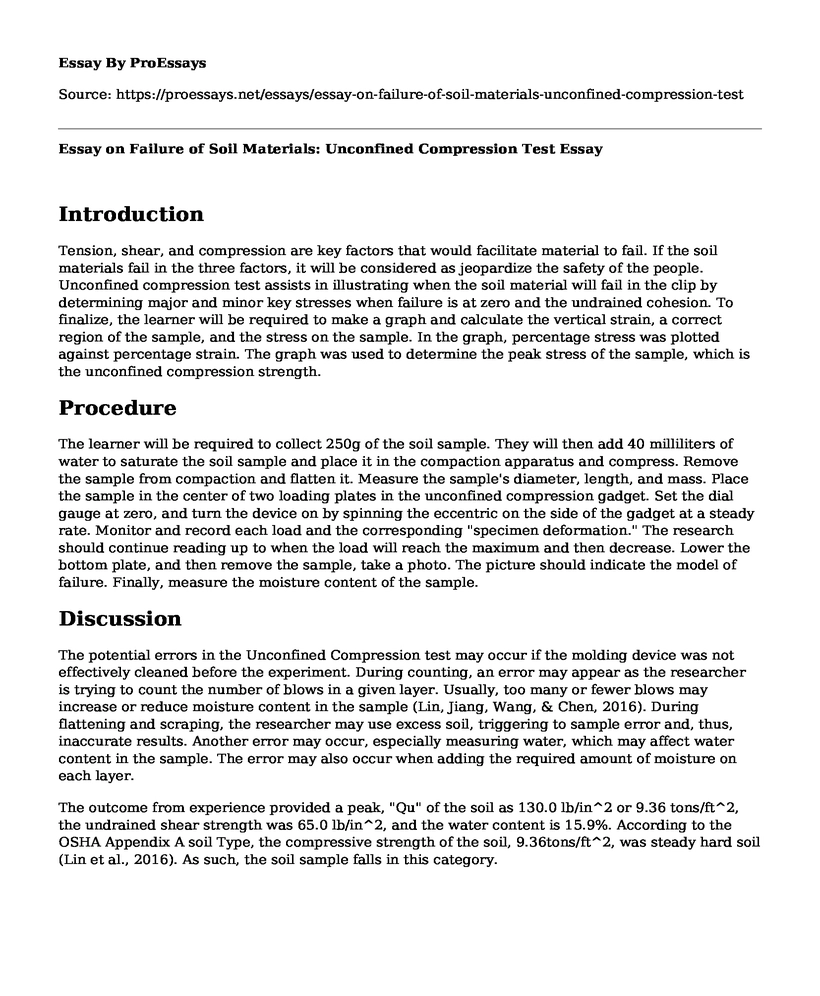Introduction
Tension, shear, and compression are key factors that would facilitate material to fail. If the soil materials fail in the three factors, it will be considered as jeopardize the safety of the people. Unconfined compression test assists in illustrating when the soil material will fail in the clip by determining major and minor key stresses when failure is at zero and the undrained cohesion. To finalize, the learner will be required to make a graph and calculate the vertical strain, a correct region of the sample, and the stress on the sample. In the graph, percentage stress was plotted against percentage strain. The graph was used to determine the peak stress of the sample, which is the unconfined compression strength.
Procedure
The learner will be required to collect 250g of the soil sample. They will then add 40 milliliters of water to saturate the soil sample and place it in the compaction apparatus and compress. Remove the sample from compaction and flatten it. Measure the sample's diameter, length, and mass. Place the sample in the center of two loading plates in the unconfined compression gadget. Set the dial gauge at zero, and turn the device on by spinning the eccentric on the side of the gadget at a steady rate. Monitor and record each load and the corresponding "specimen deformation." The research should continue reading up to when the load will reach the maximum and then decrease. Lower the bottom plate, and then remove the sample, take a photo. The picture should indicate the model of failure. Finally, measure the moisture content of the sample.
Discussion
The potential errors in the Unconfined Compression test may occur if the molding device was not effectively cleaned before the experiment. During counting, an error may appear as the researcher is trying to count the number of blows in a given layer. Usually, too many or fewer blows may increase or reduce moisture content in the sample (Lin, Jiang, Wang, & Chen, 2016). During flattening and scraping, the researcher may use excess soil, triggering to sample error and, thus, inaccurate results. Another error may occur, especially measuring water, which may affect water content in the sample. The error may also occur when adding the required amount of moisture on each layer.
The outcome from experience provided a peak, "Qu" of the soil as 130.0 lb/in^2 or 9.36 tons/ft^2, the undrained shear strength was 65.0 lb/in^2, and the water content is 15.9%. According to the OSHA Appendix A soil Type, the compressive strength of the soil, 9.36tons/ft^2, was steady hard soil (Lin et al., 2016). As such, the soil sample falls in this category.
Conclusion
The outcome in the experiment can assist a client, especially during construction, as it illustrates the nature of the soil. The unconfined compression strength was 130.0 lbs/in^2 or 9.36 tons/ft^2, and the undrained shear was 65 lb/in^2. The unconfined compression strength was the peak on the vertical strain vs. strain graph. According to the OSHA Appendix, A soil Types and the difference of unconfined compression strength and unified consistency fall within the category of hard clay (Delaine-Smith, Burney, Balkwill, & Knight, 2016). Therefore, the illustration of the soil sample is hard clay. The moisture content was consistency throughout the experiment, which was 16%. The amount of water required to attain the moisture level was 40 milliliters.
References
Delaine-Smith, R. M., Burney, S., Balkwill, F. R., & Knight, M. M. (2016). Experimental validation of a flat punch indentation methodology calibrated against unconfined compression tests for determination of soft tissue biomechanics. Journal of the mechanical behavior of biomedical materials, 60, 401-415. Retrieved from https://www.sciencedirect.com/science/article/pii/S1751616116000680.
Lin, H. D., Jiang, Y. S., Wang, C. C., & Chen, H. Y. (2016). Assessment of apparent cohesion of unsaturated lateritic soil using an unconfined compression test. Proceedings of Advances in Civil, Environmental, and Materials Research (ACEM'16). Retrieved from www.i-asem.org/publication_conf/acem16/2.ICGE16/W2C.2.GE167_0174F1.pdf.
Cite this page
Essay on Failure of Soil Materials: Unconfined Compression Test. (2023, Mar 12). Retrieved from https://proessays.net/essays/essay-on-failure-of-soil-materials-unconfined-compression-test
If you are the original author of this essay and no longer wish to have it published on the ProEssays website, please click below to request its removal:
- Ecological Impacts of Industrial Agriculture Annotated Bibliography
- Essay Sample on Why California Is Big in Agriculture
- Essay Sample on Climate Action: The Effect of Agriculture on Climate Change
- Poultry: Meat, Eggs & Science - A Vital Global Agronomic Product - Essay Sample
- Essay Example on Women in Agriculture: A Growing Concern
- Garden Grove, CA: From Small Rural Crossroads to a City of Growth and Agriculture - Essay Sample
- FDI Enhancing Agri-Productivity & Country Growth - Research Paper







